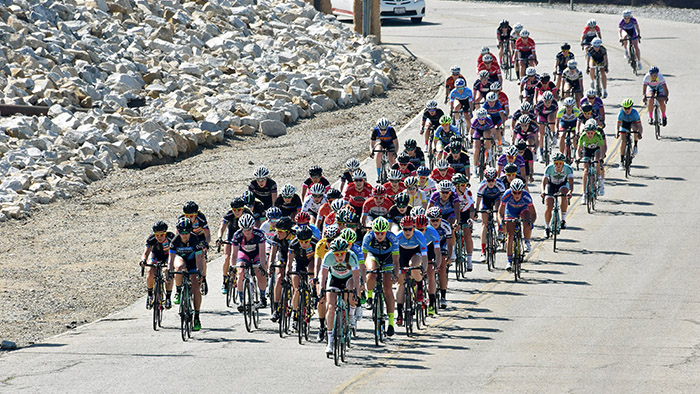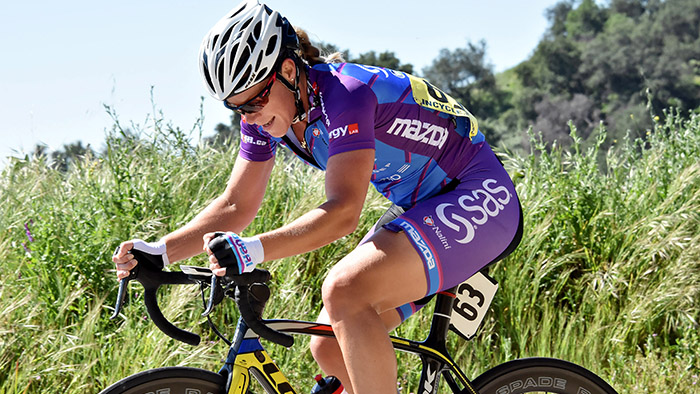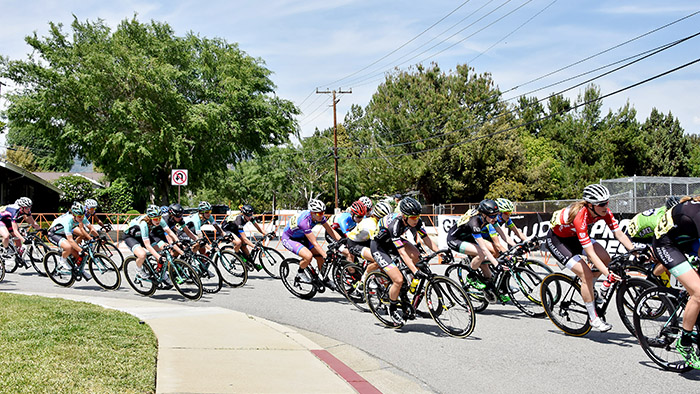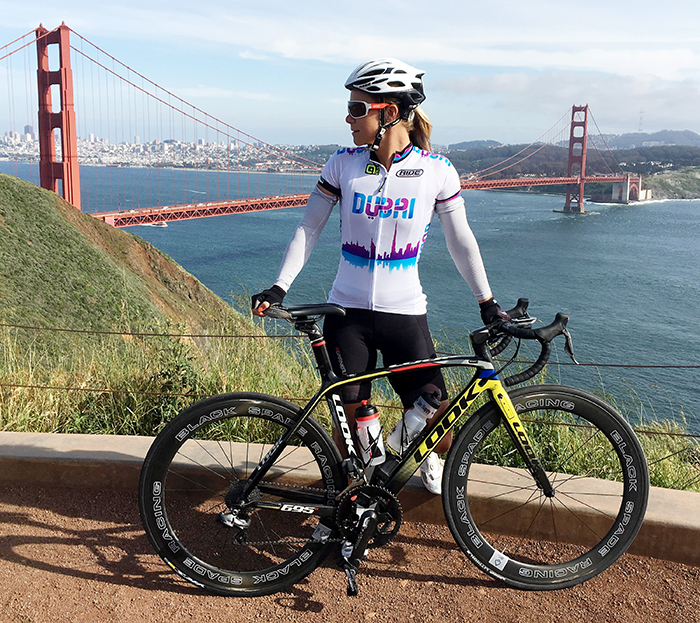Don’t you just love kicking back on the couch and watching Tour de France or other road cycling events? It is just so easy, always a pleasure and quite often also exhilarating to watch those pro riders conquer mountains and pushing their max power in the final sprint! But in reality, most people don’t know, and they will never know, what it really takes to be a pro cyclist.
Last November, I was given an incredible opportunity to race with a Canadian pro team in California as their guest rider. My training with the team coach between November and April consisted of structured intervals to improve my anaerobic capacity. Then, last month I jumped on one of the world’s longest flights from Dubai to Los Angeles to join Canadian Pro team SAS-Macogep-Mazda-Acquisio for eight stage races in California. I left the UAE with a mixed bag of butterflies, self-doubt, excitement and nerves. I knew that for me personally it was going to be the toughest race experience in my short 2.5 years of competitive cycling; but apart from that I didn’t really know what to expect, and I arrived in California with an open mind and a desire to learn as much as possible.

The events I had been invited to participate in were the San Dimas three day stage race, and the famous and longest continuous running stage race in American professional racing, the Redlands Bicycle Classics. This is a five-day stage race, attracting top US pro teams and riders such as 2x Olympic gold medallist, 43-year-old Kristin Armstrong, and one of the world’s best female climbers, Mara Abbott, who is currently contracted to world team Wiggle High5.The races included rider categories of Pro, Cat 1 and Cat 2, and most riders were racing as part of a team.
Lesson #1 – Physical Strength
These women are incredibly strong; and by that I am talking about actual power output measured in watts. To give you just a small idea of the strength difference between myself, a UAE Elite female rider, and the women at these races; during an uphill individual time trial, I set a new personal record for 20 minutes max power output, and at 64kg I placed 78th of 81 riders in total. This was an individual effort directly measured in power to weight ratio and it gave me an incredible introduction to the strength levels that were going to be required in this form of racing.
Lesson #2 – Skills
Strength is important, because without strength it is not possible to race in a bunch with these athletes. However, I quickly learnt that being skilled at bike racing is equally as important to being physically strong.

• Positioning skills
In a field of 80+ strong female riders all fighting to position themselves towards the front of the peloton, it takes quite some skill and confidence to manoeuvre oneself around the tight field. Moreover, itcan be a matter of make-or-break.Riders who can position themselves well by sitting on a strong wheel, sheltering from the wind and placing themselves near the front, can save a lot of energy. They will be at less risk of suddenly finding themselves in a position behind a rider gap that they need to close,and ultimately they will save their energy for later situations when they need to use their strength.
• Bike handling skills
Equally, sitting in a tight and fast peloton on often technical routes with narrow roads, uneven road surfaces, cones, bends and sharp corners, requires vital bike handling and control skills. Riders have to be alert at all times and ready to act quickly if another rider gets too close or if an obstacle suddenly appears. Choosing the correct line, speed and distance to other riders through corners is another required skill. Finally, handling and controlling the bike and body position while moving around a fast moving peloton is a skill that needs to be developed through practice. Braking, balancing and powering up again close to other riders are skills that every rider will use numerous times during a race.
• Anticipation and making micro-decisions
In California we raced on much more technical, undulating and hilly terrains than our average races in the Middle East. In such terrains it is important to look forward and anticipate how the group is likely to move. If a move comes as a surprise and one’s reaction is too slow, it can cost a lot of energy to fight back into the group. These little anticipated decisions along the way can save a rider valuable energy.
• Touching other riders
This is something that cannot be avoided in a tight and fast peloton with riders constantly surging towards the front. It is very important to be strong and confident on the bike and be able to take a touch, hit or push without losing control of the bike. Core control and good balance is needed to hold the position when being touched and it is important to find this control immediately as any sudden moves can result in hitting other riders and potentially cause a crash.
Lesson #3 – Mental Toughness
Bike racing at this level is tough for all riders – suffering is part of the sport. It all comes down to who has the best ability to master their pain and fatigue. For many riders there comes a time or a situation during a race where muscle fatigue or breathing difficulty becomes unbearable. The riders who succeed are the ones who have the mental and physical ability to push through this fatigue over and over. And often enough it is only a matter of seconds rather than minutes where the deeper levels are required to secure animproved position in the field.

Lesson #4 – Team Spirit
In any sport, a teamworks towards the same goal. However in cycling this goal might change from day to day. Sometimes riders have to sacrifice themselves for the success of other team riders or the success of the team. Every day new tactics are made according to the race profile, the ability of individual riders, the overall rankings and the anticipation of how other teams will approach the race.Most importantly, all riders and team staff are excited to be part of the team, excited to be competing and wholeheartedly embrace each challenge however tough it may be. Everyone is on the same page with training, recovery and nutrition and everyone has their own story as to how they reached pro level. Some have more experience than others, but ultimately everyone has exceptional drive, bags of determination and a real desire to succeed for themselves and for the team. It was truly inspiring, but also very easy to spend 24/7 with these people as everybody was supportive of each other’s different abilities within the unity of working towards the same goal.
How can we improve our female cyclists and lift the competitive level in the Middle East?
Based on this US pro cycling experience, which was only a snapshot into the world of Pro female cycling, these are some of the points I believe are necessary to develop competitive female cyclists in our region:

Time – We need time. Cycling is still relatively new in the Middle East and although cycling is booming and more people are taking up cycling, we still need time to allow for initiatives to be implemented and for more people, including youths and females, to be attracted into the sport.
Youth Development Programmes – It takes years of practice and experience to become a top performing athlete and it is necessary to create a structured, safe and supportive environment for youths, with the right tools and practices in place to help young people to progress and advance in the sport.
Increase the number of competitions – Practising provides experience. We need to practise to gain confidence, to strengthen the teams and riders and allow for different tactics to be tried and tested. For every competition there is something new to learn for all. Competitions including individual time trials, criterions and circuit races can be organised at low cost.
Build our first female continental team – It will take time to develop the riders and the success of the team, but we have to start somewhere. It will require financial support and sponsors to enable the team to travel outside the Middle East to gain experience and to represent female cyclists from this region. It will take time, effort and support and it will be a developing process, but it is possible.
If you are interested in women’s professional cycling, the most important stage race in the Women’s World Tour, the 27th edition of the Giro Rosa runs from 1st till 10th July 2016.
Words by: Helle Bachofen von Echt
Photos by: Annette McCusker
Helle Bachofen von Echt is a Dubai-based sponsored Elite Road Cyclist competing in both local and international events. When she is not training, she is helping others achieve their health and fitness goals by running her own personal training services as well as giving indoor cycling classes. Helle loves travelling with her bike and you can follow her adventures and racing on Instagram @thegirlwhocyclesinthedesert.

